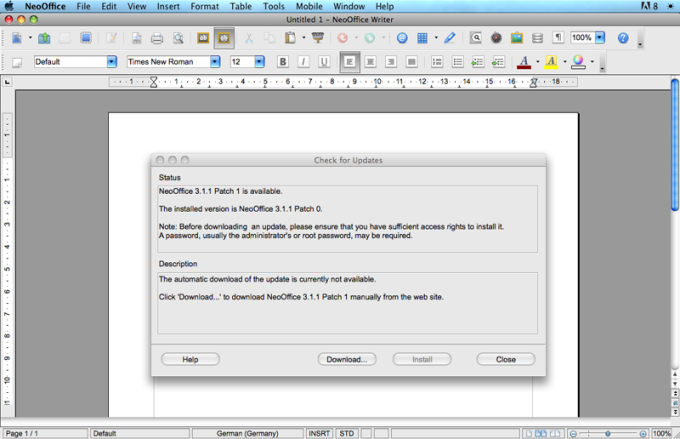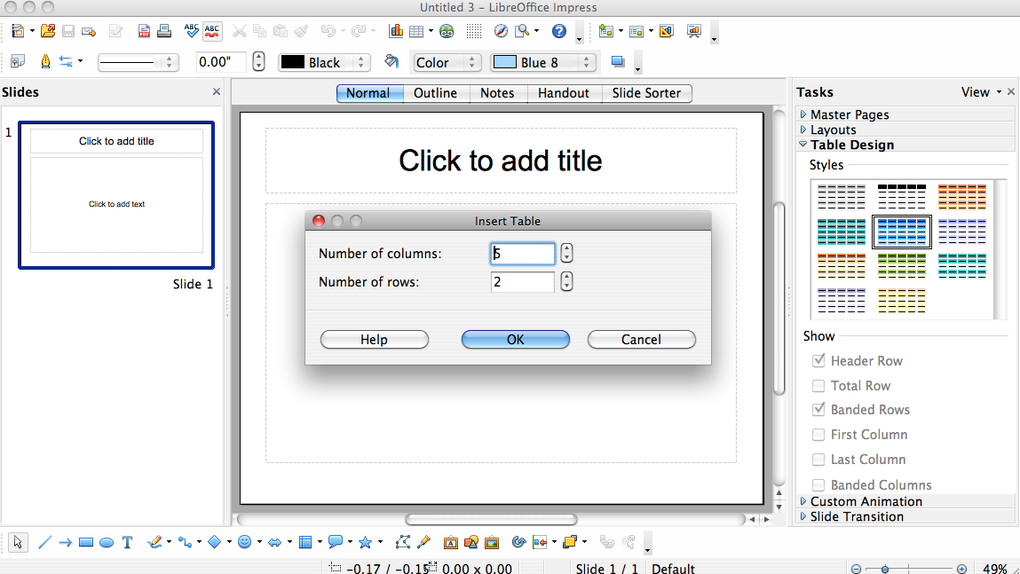- Libreoffice Mac Os X 10.6
- Libreoffice Mac Os X
- Libreoffice Mac Os X 10.6.8 Download
- Libreoffice Free Download
- Libreoffice Mac Os X 10.7.5
Download free office suite for Windows, macOS and Linux. Microsoft compatible, based on OpenOffice, and updated regularly. LibreOffice / ˈ l iː b r ə / is a free and open-source office productivity software suite, a project of The Document Foundation (TDF). It was forked in 2010 from OpenOffice.org, which was an open-sourced version of the earlier StarOffice.
Libreoffice Mac Os X 10.6
LibreOffice Fresh
Main Installer
Selected: LibreOffice 7.1.2 for macOS x86_64 (10.10 or newer required) - change?
260 MB (Torrent, Info)
SDK and Sourcecode
Libreoffice Mac Os X
Download the SDK
LibreOffice_7.1.2_MacOS_x86-64_sdk.dmg
45 MB (Torrent, Info)
Download the Sourcecode
- libreoffice-7.1.2.2.tar.xz
233 MB (Torrent, Info) - libreoffice-dictionaries-7.1.2.2.tar.xz
45 MB (Torrent, Info) - libreoffice-help-7.1.2.2.tar.xz
107 MB (Torrent, Info) - libreoffice-translations-7.1.2.2.tar.xz
176 MB (Torrent, Info)
Operating Systems
LibreOffice 7.1.2 is available for the following operating systems/architectures:
Available Versions
LibreOffice is available in the following released versions:
LibreOffice is available in the following prerelease versions:
Older versions of LibreOffice (no longer updated!) are available in the archive
LibreOffice for other operating systems
LibreOffice in other languages
How do I install LibreOffice?
System requirements
Extensions
- → Open Issues
The user profile is the folder storing all user related data like extensions, custom dictionaries, templates, etc. This folder is not removed when uninstalling or updating LibreOffice, so your customizations are kept.
Backup first
Before modifying your user profile, create a backup so you can return to the old user profile.
LibreOffice developers might ask for a copy of your user profile for debugging and bugfixing so please do not delete the backup file instantly.
Note: if you heavily customize LibreOffice, then making a periodic backup of the profile may help in case of problem. Even if shortcuts, user interface, etc. can be exported through single configuration files, restoring the whole profile will spare you the import of each single configuration file and the reinstallation of the extensions you could have added.
Resolving corruption
Many problems in LibreOffice can be caused by corruption in the user profile.
When noticing strange behavior in LibreOffice the first thing to do is to reset the user profile. To do so, 2 methods are available.
Help wizard (LibreOffice 5.3 and newer)
- Start LibreOffice and select Help ▸ Restart in Safe Mode
- In the Enter Safe Mode dialog select Restart
- LibreOffice will restart and display the Safe Mode dialog
- If your problem is that LibreOffice does not start at all, launch it from the command line with
libreoffice --safe-modeor use the start menu entry LibreOffice (Safe Mode) on Windows
- Select Continue in Safe Mode
- Test and see if the problem is gone.
- If the problem persists, you can exit the safe mode because the user profile was not the cause of the problem.
- If the problem is solved, something is wrong with your configuration. Start LibreOffice in safe mode again to see the safe mode dialog. You can now try to disable Hardware acceleration or to restore/reset your user profile.
Manual procedure (all versions)
If you are using an old version of LibreOffice, or if the Help wizard procedure detailed above seems too complicated:
- Close LibreOffice including 'QuickStart' in system tray.
- Find your user profile per information below, according to your operating system.
- Rename the folder
/userto (for example)/user-old. - Launch LibreOffice, a new
/userfolder will be created with factory settings.
- Test and see if the problem is gone.
- If the problem persists, you can restore the previous profile because it was not the cause of the problem. To do so, delete the newly created
/userfolder and give the renamed old one its former name/userback. - If the problem is solved, it means that one or several configuration files were damaged. But it doesn't mean that the whole profile is dead. If you have heavily customized LibreOffice, you can still try to retrieve some parts of your configuration: as you have kept a backup (
/user-old), copy the subfolders (one at a time), and restart LibreOffice to see if the issue comes back or not. You can therefore spot from where the issue comes. Look at the content of the profile (below), some are less prone to corruption than others.
- If the problem persists, you can restore the previous profile because it was not the cause of the problem. To do so, delete the newly created

Expert information
Find the location of your user profile: Tools ▸ Options ▸ LibreOffice ▸ Paths.
Default locations
The number used in the path below refers to the last major version of LibreOffice that created that kind of profile. The format has changed from LibreOffice 3 to LibreOffice 4. You might wonder why the number has not increased with LibreOffice 5; this is because the format has not changed since LibreOffice 4. Changing that number will lose the user's personal configuration. If LibreOffice changes or removes this number in the future, then your own scripts must be modified.

Windows
%APPDATA%libreoffice4user(LibreOffice 4 to 7)%APPDATA%libreoffice3user(LibreOffice 3)
Note: on a normal Windows install, %APPDATA% resolves to C:Users<user name>AppDataRoaming, at least on English versions of Windows Vista and later (part of the path may be localized on non-English versions).
Thus, you can copy and paste %APPDATA%libreoffice4 in the File Explorer Address Bar and press ↵ Enter to access it directly. Or press ⊞ Win+r and write %appdata% and hit ↵ Enter.
GNU/Linux
/home/<user name>/.config/libreoffice/4/user(LibreOffice 4 to 7)/home/<user name>/.config/libreoffice/3/user(LibreOffice 3 since 3.5.0)/home/<user name>/.libreoffice/3/user(prior to LibreOffice 3.5.0)
Note: This is for the LibreOffice packages distributed by The Document Foundation. Versions provided by your Linux distribution may use a slightly different path.
Remember that the .config folder is a hidden folder in your /home.
macOS
~/Library/Application Support/LibreOffice/4/user(LibreOffice 4 to 7)~/Library/Application Support/libreoffice/3/user(LibreOffice 3)
For LibreOffice Vanilla provided by Collabora at the App Store check
~/Library/Containers/com.collabora.libreoffice-free(LibreOffice 5.4)
LibreOffice Portable
LibreOfficePortableDatasettingsuser
User profile content
Inside the user profile there are several highly specialized folders:
- autocorr: the substitution table you can configure on Tools ▸ AutoCorrect ▸ AutoCorrect Options...
- autotext: the 'AutoText' (Tools ▸ AutoText) you created.
- backup: the file backups you get when enabling the option Always create backup copy is enabled under Tools ▸ Options ▸ Load/Save ▸ General.
- basic: all your macros.
- config: some configuration files, especially toolbars for each module. Custom color palettes are also stored here.
- database: the databases you registered.
- extensions: registered extensions
- gallery: your personal gallery (View ▸ Gallery).
- psprint: may contain a 'driver' subfolder (which may be empty), a 'fontmetric' subfolder (which may be empty), and a 'pspfontcache' file (in which printer fonts are cached). The 'psprint' folder may be missing entirely. If it is present, it may be deleted without ill effect. If it is deleted, it will not necessarily be recreated.
- registry: contents the most part of the configuration files.
- Scripts: contains the optional Folders for user-defined scripts: beanshell, java, javascript and python. (for example the scripts you find over: Tools ▸ Macros ▸ Organize Macros ▸ Python ▸ My Macros)
- store: may either be empty or contain a file named '.templdir.cache' (in which templates are cached). The 'store' folder may be missing entirely but is usually present. If present, it may be deleted without ill effect. If it is deleted, it is usually but not always recreated.
- temp: may contain an 'embeddedfonts' subfolder that in turn contains a 'fromdocs' subfolder and a 'fromsystem' subfolder. The 'fromdocs' and 'fromsystem' subfolders may either be empty or contain temporary files. The 'temp' folder may also contain a file named 'document_io_logring.txt', which is a log of executed instructions. The 'temp' folder may be missing entirely. If it is present, it may be deleted without ill effect. If it is deleted, is is not always recreated.
- template: here you can find your custom templates (File ▸ Templates ▸ Organize ▸ My templates)
- uno_packages: the extensions installed by the user.
- wordbook: the custom dictionaries. (see also this tutorial)
Libreoffice Mac Os X 10.6.8 Download

Some extensions (like OOoLatex) could add other folders.
NOTE: other than the user profile, LibreOffice considers the configuration for all users you can find in the subfolders inside the main installation folder (for example, /opt/libreoffice/share on Linux for the 'official' LibreOffice build, or Program fileslibreofficeshare on Windows)
Libreoffice Free Download
Reusing user profiles
A single user profile must only ever be accessed by a single LibreOffice process. Internally, if a single user starts multiple LibreOffice processes that would all access the same user profile, only the first process does any actual work, like opening documents for editing, and the excess processes pass on their command line arguments to the first one for processing. Especially, one must not reuse a single user profile across multiple accounts on one computer, or across computers.
Libreoffice Mac Os X 10.7.5
Also, different versions of LibreOffice can store different sorts of data in their respective user profiles. If a new version of LibreOffice does not yet find a user profile at the default location for that version, it looks for existing user profiles from old LibreOffice or OpenOffice.org versions at well-known locations and migrates any data it can continue to use to the new location. Strange effects might occur, if you explicitly request a LibreOffice version to reuse a user profile from another version.
However, most of the content of the user profile can be safely copied from a machine to another to duplicate the same configuration. Especially custom dictionaries, color palettes, shortcuts, toolbars, extensions...
